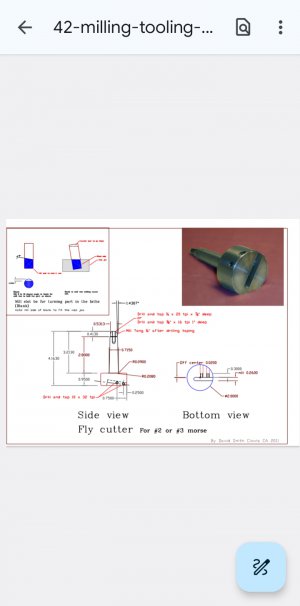A simple fly cutter is inexpensive and will do a good job at facing anything we do. The high speed steel is easy to resharpen. No expensive inserts to replace. The face mills are great for production , but for what I do it is a waste of money. Keep it simple and only buy what you need as you go along.
-
Welcome back Guest! Did you know you can mentor other members here at H-M? If not, please check out our Relaunch of Hobby Machinist Mentoring Program!
You are using an out of date browser. It may not display this or other websites correctly.
You should upgrade or use an alternative browser.
You should upgrade or use an alternative browser.
Facing with a mill
- Thread starter Archer60x
- Start date
- Joined
- Dec 18, 2022
- Messages
- 1,739
I have been happy with the tooling I ordered from PM with my machines, its all been good quality. I had a set ER40 collet I purchased from PM which were very good.I hope the collets i got are good. There were the "ultra precision ones" that you can choose to package with the mill. I am finding that ULTRA precision, precision are terms that dont seem to hold much weight. Kind of like the labels on the food. "Good For Your Heart"
Ultra Precision 11 Pc. R-8 Collet Set – Precision Matthews Machinery Co.
www.precisionmatthews.com
- Joined
- Jun 12, 2014
- Messages
- 4,817
Fly cutters are limited by the speed and depth of the cut, as well as vibration from balance. The issue with poorly made face mills and inserts is often poorly machine insert pockets and slight variations in insert size/seating which will cause ridges. I run my face mills 2-4" in aluminum at around 3200-3500 RPM and they have between 5-8 inserts, so rapid stock removal if you need to size material. A fly cutter with a single insert does give an excellent surface finish, many people use the Tormach, but you can also make your own. Getting the right insert/cutting geometry is also important. Buying a better made face mill, basically you are buying once. Inserts typically run around $70 for a box of 10, I figure with the Haas face mill with 5 inserts and 6 cutting edges, I doubt that I will ever need to buy another box in the next 10-20 years. So cost is relative, when you factor the decreased time to remove material and get a clean finish. One last point is that you need to advance the cutter in an even manner to get a good surface, i.e. you need a power feed. Use some WD40 and or a air to clear the chips.

 tormach.com
tormach.com
The issue with poorly made face mills:
Sizing material with a 4" face mill, 3200 RPM, 12IPM, DOC 0.1" if I recall. The feed can be increased significantly if just for material removal.
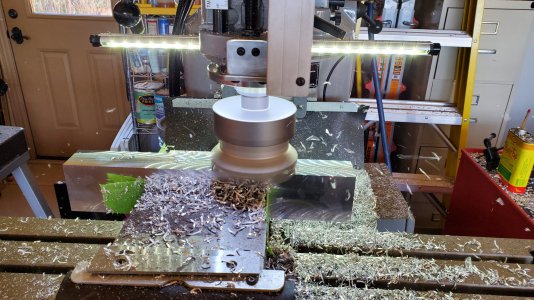
Shouldering with a rougher climb cutting for rapid removal of material and pocketing:
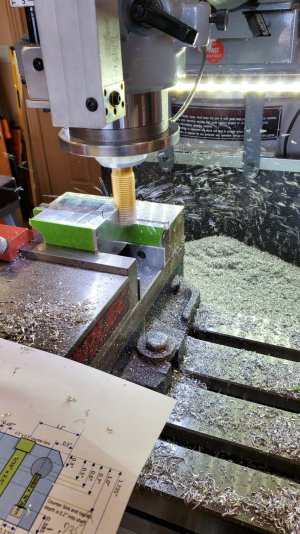

The Science of Face Milling with a Fly Cutter
Some people think of face mills as large diameter tools with lots of inserts. These kinds of face mills need big spindles to push them efficiently, but a fly cutter provides ...
The issue with poorly made face mills:
Sizing material with a 4" face mill, 3200 RPM, 12IPM, DOC 0.1" if I recall. The feed can be increased significantly if just for material removal.

Shouldering with a rougher climb cutting for rapid removal of material and pocketing:

- Joined
- Apr 23, 2018
- Messages
- 6,556
My preferred facing tool is definitely the 2" 90 degree face mill. It does heavy cuts just as easy as light ones, and finish is acceptable. I got three "used" Kennametal insert mills on eBay for $36 (one ended up in the pass around box awhile back...), so china isn't the only option. I take .250 dry cuts in steel without issue.
This pic looks brutal, but I can do this all day long. The smoke is a few drops of castor oil, a habit I've since abandoned.
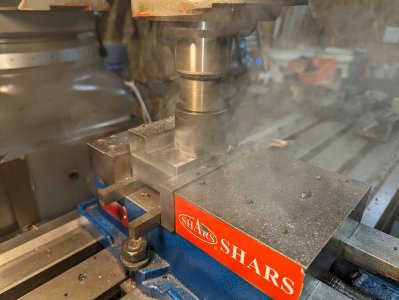
Fly cutting is fantastic for primo finishes, but can be painfully slow for roughing. I love grinding HSS bits and seeing the gleaming results, but I never fly cut for squaring or roughing.
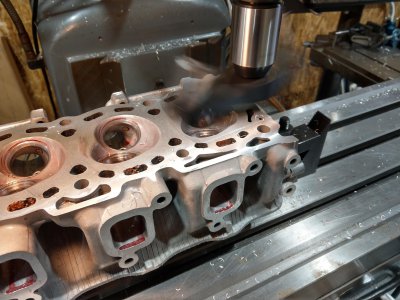
This pic looks brutal, but I can do this all day long. The smoke is a few drops of castor oil, a habit I've since abandoned.

Fly cutting is fantastic for primo finishes, but can be painfully slow for roughing. I love grinding HSS bits and seeing the gleaming results, but I never fly cut for squaring or roughing.

- Joined
- Feb 21, 2022
- Messages
- 771
Don't get drawn into flycutting...
They are hard on your spindle bearings, especially if it is a hobby size.
They can be very dangerous, especially when the tool extends past the cutter body it becomes invisible.
A flycutter is a face mill with one insert left in, but far less balanced.
Modern tool manufacturers can make inserts and pockets that are extremely accurate to one another for superb finishes.
For the best tool life and finish, get a button insert face mill, look for a close pitch for higher mmr & smoother cutting.
They are hard on your spindle bearings, especially if it is a hobby size.
They can be very dangerous, especially when the tool extends past the cutter body it becomes invisible.
A flycutter is a face mill with one insert left in, but far less balanced.
Modern tool manufacturers can make inserts and pockets that are extremely accurate to one another for superb finishes.
For the best tool life and finish, get a button insert face mill, look for a close pitch for higher mmr & smoother cutting.
- Joined
- Dec 18, 2019
- Messages
- 6,464
This works well, and is rather inexpensive. Still on the first 4 inserts, haven't even had to rotate them yet. I want to thank @MrWhoopee (again!) for his recommendation, because this is darn good for the cash outlay. Remember to get a arbor for it, an R8 arbor is not much money. Really like mine.
- Joined
- Mar 27, 2022
- Messages
- 425
It was kind of mentioned by @Parlo but if you bought a face mill you could remove all but one insert and basically achieve a fly cutter. I understand his opposition to fly cutters but everything is dangerous when abused. Fly cutters have place, use very light facing cuts. They have the advantage of being cheap and large. A 6 or 7 inch face mill would be expensive, fly cutter not so much.
- Joined
- Apr 13, 2023
- Messages
- 201
That's an impressive RPM for a 4" cutter.Sizing material with a 4" face mill, 3200 RPM, 12IPM, DOC 0.1" if I recall.
- Joined
- Jun 12, 2014
- Messages
- 4,817
The face mill is made by Iscar, if I recall the maximum RPM is around 6,000, but one needs to be cautious as the specs. are for each model of face mill. At the time, I bought it new for pennies on the dollar, the downside like so many of these NOS/used face mills is they are no longer made and the inserts are difficult to source and expensive. This particular face mill F45KT can take either octangle or round inserts, and 7 at a time, they have 8 cutting edges. The newer Isacr models of this face mill use thicker inserts that can be flipped, so 16 cutting edges per insert. I have several boxes of inserts for ferrous materials and only one for aluminum, but one set of inserts will most likely exceed my lifetime supply need. I only use it for sizing and finishing in aluminum (6061, 7075), my mill has no issues with power or vibration. The insert pockets have a fairly steep positive forward rake which decreases the cutting Hp. In steel I primarily use the Haas mentioned, and it gives almost a mirror finish on steel. I use a Sowa R8 shell mill arbor on some of my face mills, they are reasonably priced and very accurate. I added this 4" face mill because I was doing a lot of facing in stock between 2-4" in width.
The bottom line is that one should just not runout and hunt for the cheapest or something great buy on eBay that is no longer supported. There are thousands of models and different inserts, many which are proprietary to that model/manufacturer. If you do buy a face mill either buy one that takes common inserts, or once your are satisfied with the face mill performance buy extra inserts. I have 6 different face mills and a pile of inserts for them. But with what I know now, I probably would go with the Haas when they are on sale or similar quality face mill that takes standard inserts that will be readily available in the future.
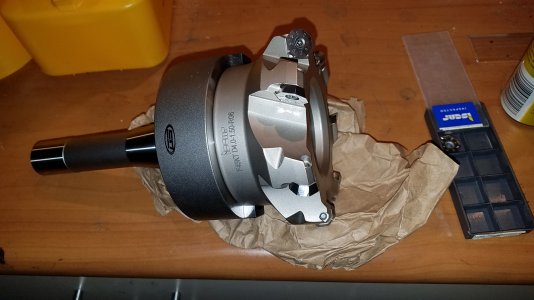
The bottom line is that one should just not runout and hunt for the cheapest or something great buy on eBay that is no longer supported. There are thousands of models and different inserts, many which are proprietary to that model/manufacturer. If you do buy a face mill either buy one that takes common inserts, or once your are satisfied with the face mill performance buy extra inserts. I have 6 different face mills and a pile of inserts for them. But with what I know now, I probably would go with the Haas when they are on sale or similar quality face mill that takes standard inserts that will be readily available in the future.



